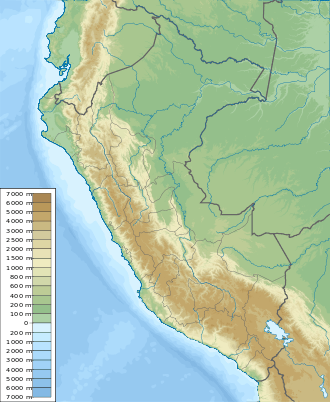1942 Peru earthquake
 | |
| UTC time | 1942-08-24 22:50:31 |
|---|---|
| ISC event | 900444 |
| USGS-ANSS | ComCat |
| Local date | August 24, 1942 |
| Local time | 17:50 |
| Magnitude | Mw 8.2 |
| Depth | 35 km (22 mi) [1] |
| Epicenter | 14°59′S 74°55′W / 14.98°S 74.92°W [1] |
| Type | Megathrust |
| Areas affected | Peru |
| Max. intensity | IX (Violent) |
| Casualties | 30 |
The 1942 Peru earthquake occurred on August 24 at 17:50 local time and was located near the border of the departments of Ica and Arequipa, Peru. It had a magnitude of Mw 8.2 or Ms 8.4.[2][3][4]
Earthquake
This is a megathrust earthquake which ruptured part of the boundary between the Nazca Plate and the South American Plate.[5][6] In this area, the Nazca Plate is subducting beneath the South America Plate with a convergence vector of about 7.6 cm/yr. Much of the rupture zone of the 1942 earthquake overlapped with that of the 1996 Nazca earthquake. The rupture zone of the 1942 earthquake was about 40 km longer than that of the 1996 earthquake.[7] The epicenter of the 1942 earthquake was very close to, but slightly southeast of, that of the 1996 earthquake.[8] The energy released by the 1942 earthquake was about 2.5×1017 Nm.[4]
Damage
The earthquake caused 30 deaths and 25 injuries. Building damage was noteworthy in the epicentral area. About 30% of the buildings in the city of Nazca were ruined. There were slides in the hills. The intensity reached IX (Violent).[2]
Tsunami
This earthquake triggered a tsunami. In Callao, the amplitude of the oscillations of the tsunami was 1.6 m.[9] In Lomas, the sea receded more than 200 m, and then it flooded the settlement with injuries reported.[10]
See also
References
- 1 2 Engdahl, E. R.; Vallaseñor, A. (2002). "Global seismicity: 1900–1999". International Handbook of Earthquake & Engineering Seismology (PDF). Part A, Volume 81A (First ed.). Academic Press. p. 678. ISBN 978-0124406520.
- 1 2 https://earthquake.usgs.gov/earthquakes/world/events/1942_08_24.php
- ↑ Ruff, L. J (1989), "Do trench sediments affect great earthquake occurrence in subduction zones?", Pure and Applied Geophysics, 129: 263, Bibcode:1989PApGe.129..263R, doi:10.1007/BF00874629
- 1 2 "Archived copy" (PDF). Archived from the original (PDF) on 2013-10-20. Retrieved 2012-09-27.
- ↑ Chlieh, M.; Perfettini, H.; Tavera, H.; Avouac, J.-P.; Remy, D.; Nocquet, J.-M.; Rolandone, F.; Bondoux, F.; Gabalda, G.; Bonvalot, S. (2011), "Interseismic coupling and seismic potential along the Central Andes subduction zone" (PDF), Journal of Geophysical Research, 116: B12405, Bibcode:2011JGRB..11612405C, doi:10.1029/2010JB008166
- ↑ http://www2.ess.ucla.edu/~giovanni/new_site/Giovanni_etal_2002.pdf
- ↑ ftp://white-dome.gps.caltech.edu/pub/avouac/Ge277-2007-fall/Spence_PAG1999.pdf
- ↑ Swenson, J. L; Beck, S. L (1999), "Source Characteristics of the 12 November 1996 M w 7.7 Peru Subduction Zone Earthquake", Pure and Applied Geophysics, 154 (3–4): 731, Bibcode:1999PApGe.154..731S, doi:10.1007/s000240050250
- ↑ National Geophysical Data Center / World Data Service (NGDC/WDS), Significant Earthquake Database, National Geophysical Data Center, NOAA, doi:10.7289/V5TD9V7K
- ↑ http://desastres.unanleon.edu.ni/pdf2/2005/enero/parte1/pdf/spa/doc9644/doc9644-b5.pdf%5Bpermanent+dead+link%5D
External links
- The International Seismological Centre has a bibliography and/or authoritative data for this event.